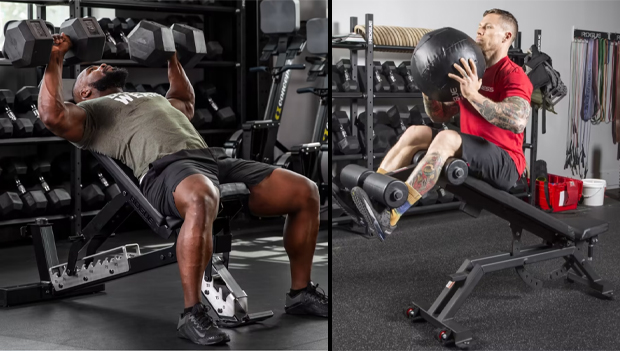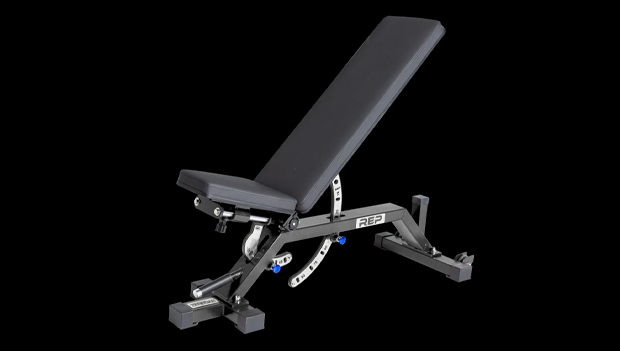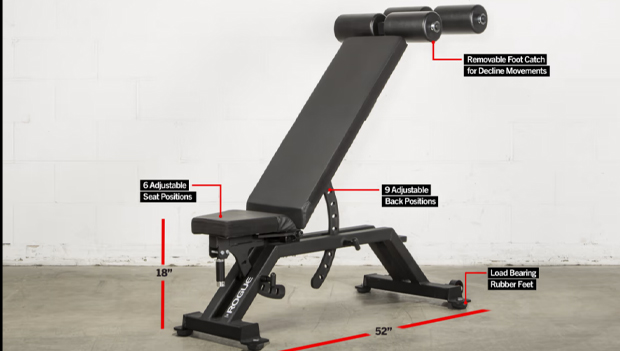
By clicking on the product links in this article, we may receive a commission fee at no cost to you, the reader. Sponsorships and affiliate commissions help support our research so we can help you find the best products. Read the full affiliate disclosure here.
Bench press is one of the most popular exercises in the gym. This makes sense because chest muscles are big and powerful, so pushing heavy weight gives you an immediate pump. I used to love chest day for this very reason. My go-to workout was to hop on an open weight bench, load up the barbell with heavy weights, and start pushing.
Our Favorite Incline Benches
Our Favorite Decline Benches
But when I hit a plateau, I was stumped. I downloaded weightlifting apps, did push-ups, started using dumbbells instead of barbells for chest work, and I even bought a set of kettlebells for my house so I could take a break from the gym. Nothing worked—until I stumbled onto bench press variations. In this article, we're going to talk about the incline versus decline bench press variations, which muscles they target, how to perform each lift properly, and the overall benefits of the lifts. If you're trying to get stronger, push through a plateau, or correct muscle imbalances, then read on.
Why Trust Us?
The health and safety of ACTIVE's readers is of the utmost importance to us. To ensure your well-being when consuming protein powders, the ACTIVE.com editorial team prioritizes products that are independently tested by a third-party. We've also consulted with a team of nutritionists and dieticians to ensure the products we feature are of the highest standard. This helps us create the most accurate, authentic review content for our readers. More importantly, fitness may be our job, but it is also our passion. Therefore, we strive to bring you products that we trust and would personally use.
What Is an Incline Bench Press?

The incline bench press is a chest exercise that raises the angle of your body to put a heavier load on your upper chest, deltoids, and triceps than the typical flat bench press. Incline presses can be performed at many different angles, but the most common are 30 and 45 degrees.
Either angle will target your upper chest, but the difference is in the secondary muscles. At 30 degrees you will use your lower chest more heavily while at 45 degrees you will activate your deltoids and triceps.
Muscles Targeted
- Upper chest
- Lower chest
- Front deltoids
- Triceps
How To: Incline Bench Press
The Set-Up: Before you can perform the lift properly, you have to make sure you're set up. For incline bench press, your incline angle should be either 30 or 45 degrees, depending on what secondary muscles you want to activate. 30 degrees uses your lower chest and 45 degrees activates your shoulder muscles.
The Lift:
- Lie on your back under the bar. Make sure your body is even on the bench and your feet are flat on the floor.
- Grip the bar slightly wider than shoulder-width, using the knurling to make sure your hands are balanced.
- Unrack the weight and hold with your arms extended over the center of your chest.
- Slowly lower the weight to your chest and then push it back to the starting position.
Pro Tips:
- For an extra challenge, pause for one or two seconds with the bar touching your chest before pushing the weight back up. That pause will give your muscles a chance to release the tension so you'll rely less on momentum and more on strength.
- To get the most benefit from the lift, keep your elbows perpendicular to the floor. The more you angle them away from your body the more strain you're putting on your joints.
Benefits of Incline Bench Press
- Incline bench press is a great way to target muscle imbalances in your chest and get a good pump in your front deltoids.
- If you're new to the incline bench you'll notice your overall upper body strength increase, particularly for other chest-focused lifts.
- If you're using good form, your triceps should carry a bigger load than with the flat bench.
Our Favorite Incline Benches
What Is a Decline Bench Press?

If the incline bench press targets your upper chest by raising your body's position, the decline bench press does the opposite and targets your lower chest. You'll still recruit some of the same secondary muscles, but one major difference is that you will likely be able to lift more weight than on a flat or incline bench.
If you've ever seen someone arching their back intentionally on a flat bench, what they are doing is mimicking a decline bench press. The key is a lower range of motion and a heavier dependence on the lower chest, which is bigger and more powerful than the upper chest.
Target Muscles
- Lower chest
- Biceps
- Triceps
- Deltoids
How To: Decline Bench Press
The Set-Up: If you're using an adjustable bench at home, then it likely does not have a specific decline bench press setting. But to accommodate this, many brands have made the weight bench seat adjustable and sell an attachment to anchor your feet.
If you go to a commercial gym with an incline press, then the angle and feet anchors should be set for you. If you're working out at home, keep the bench angle at 15 or 30 degrees. Anything lower increases your risk without much, if any, benefit. Make sure you're using all safety attachments your brand of bench recommends for the lift.
The Lift:
- Lie on your back underneath the barbell. Make sure your body is even on the bench and stable.
- Grip the bar a little bit wider than shoulder-width and use the knurling on the barbell to make sure your hands are balanced.
- Unrack the weight and position the bar above your mid or lower chest.
- Slowly lower the weight until it touches your chest and push it back up to the starting position.
Pro Tips:
- Similar to the incline bench, the pausing method will instantly give you a better workout. Plus, you'll avoid the injury risk that comes with bouncing the weight off your chest.
- Your body will feel weird the first few times you perform this lift, so take the weight off to start and focus on your form. Your forearms should be perpendicular to the floor and your elbows should move down, not out.
Benefits of Decline Bench Press
- Decline hits your chest muscles from a different position, which will improve your overall upper body strength.
- Helps grow your deltoids and triceps
- Decline bench press makes it easier to break the habit of arching your back during a flat bench press.
Our Favorite Decline Benches
My favorite thing about these two benches is that you can use them for either incline or decline bench press, depending on how you adjust the seat and back angles. Plus, both brands make an anchor attachment for your feet, which is absolutely necessary for safety.
Incline vs. Decline Benches: Which is Better?
Decline vs. incline bench press is a debate without a real answer because which is better depends on your training regimen. While there are benefits to the decline bench press that shouldn't be ignored, my experience tells me that most people have not targeted their upper chest specifically, making the incline bench press a better addition to your workout.
Addressing your strength imbalances is the best way to push through plateaus, spice up your workout so you don't get bored, and look and feel stronger. If you're already doing the flat bench, push-ups, or dumbbell bench press work, then I highly recommend adding the incline bench into your routine.
FAQs About Incline vs. Decline Benches
Are incline and decline benches necessary?
Incline and decline bench will give you versatile workout options. Plus, many good adjustable benches like the REP AB-5000 can do both so you don't need to invest in two benches.
Is an incline or decline bench better for the chest?
Incline and decline bench press are both great for your chest, but they work different areas. The incline bench press works your upper chest along with secondary muscles while the decline bench works your lower chest and slightly different secondary muscles.
Which bench press is the hardest?
Each type of bench press targets a different part of the chest and recruits different secondary muscles. For most people, the incline bench press will be the hardest because their upper chest is underdeveloped compared to their lower chest.


